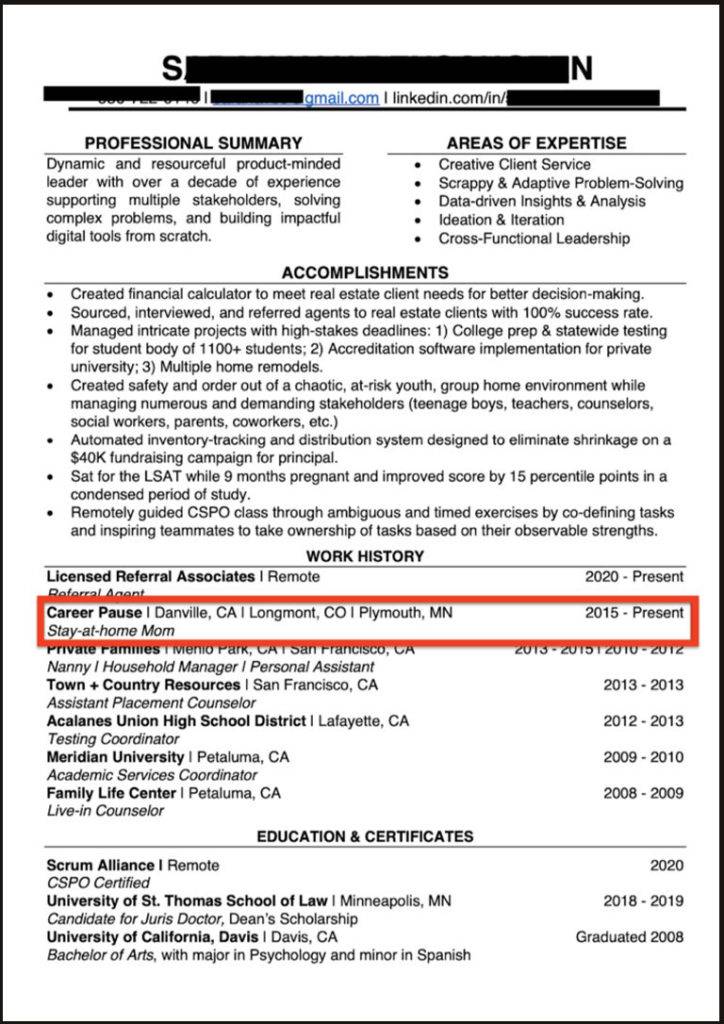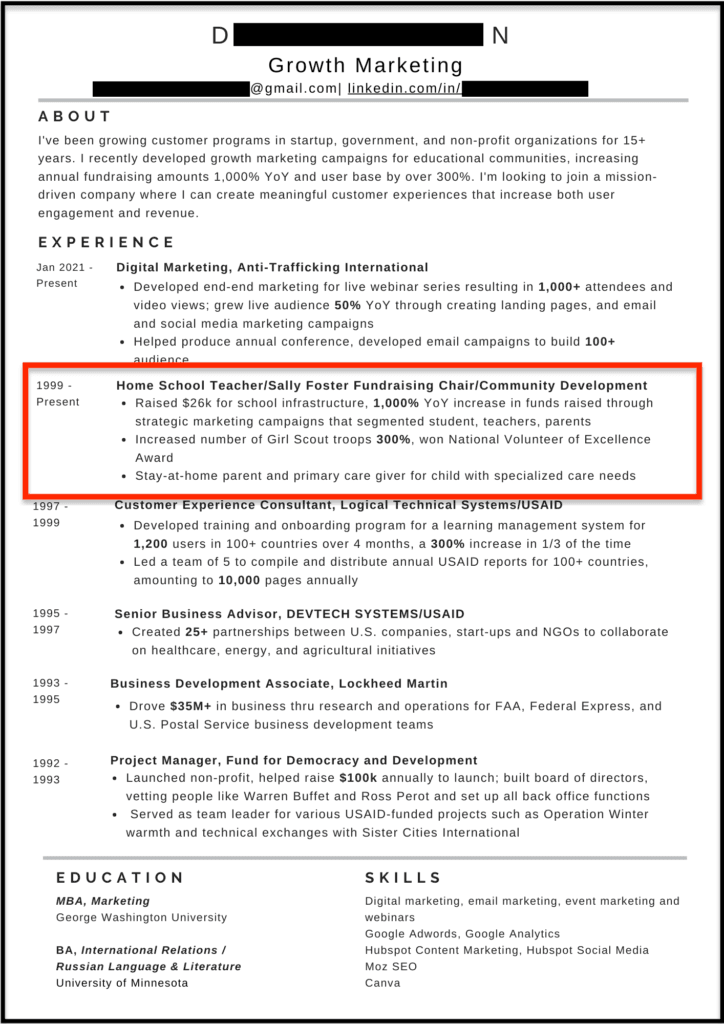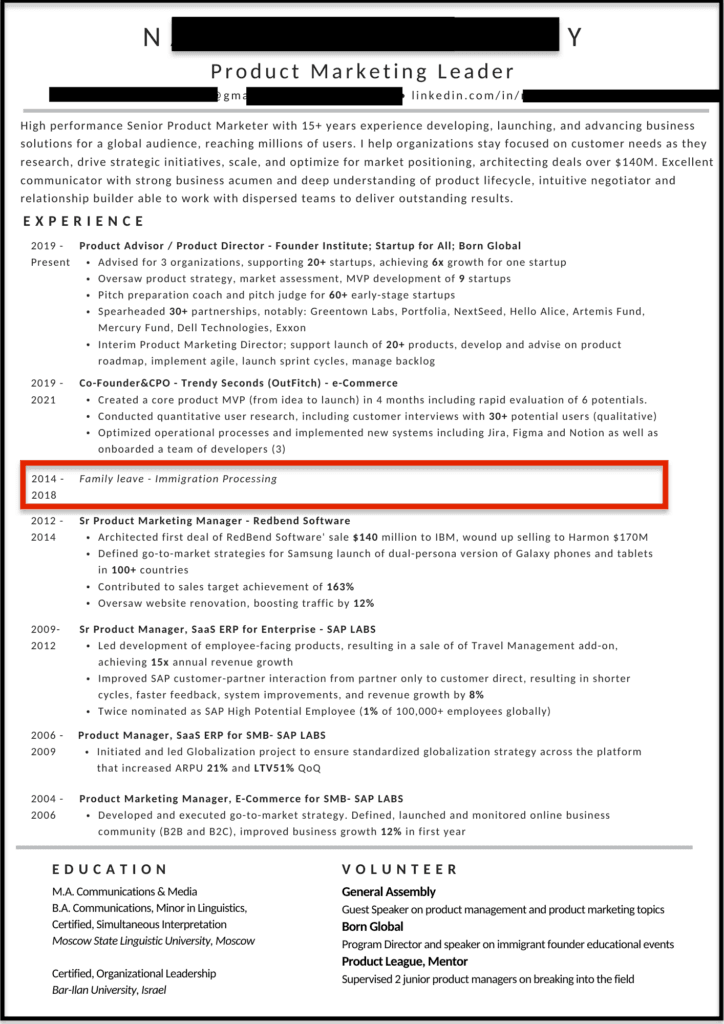When you’ve spent years of your life wiping bums, managing cookie negotiations, outwitting stall tactics, and juggling naps, the concept of putting yourself out there — whether for a career relaunch or even just a transition — can feel daunting.
You have children on the brain during most waking hours, you’re self-conscious of any gaping holes on your resume, networking seems like a double dare, and especially if you have little to no recent paid experience, your confidence may be at an all-time low.
Seems like a perfect foundation for building a personal brand, right?
Kidding.
But hear me out. Let me tell you why it’s essential for your job search and how to do it, even if you have a gap and all the self-doubt in the world.
WHAT IS PERSONAL BRANDING?
A personal brand is the culmination of things that distinguish you from your job-seeker competitors: it is a reflection of your unique skills, passion, values, work strengths, personality traits, and unique experience(s), accomplishments, abilities, and soft skills, among other things. It’s a marketing tool — a strategy — for your candidacy that encapsulates who you are, what makes you unique, how you solve problems, and what solutions you offer a target company to reach their goals and achieve their mission.
A personal brand is a “career identity” with a dynamic message: a unique value proposition to prospective employers. A powerful personal brand delivers a clear solutions-focused message that is impactful and captivating.
You might feel unworthy of “be”-ing a brand. Or, this all might be a bit of a turn-off. Trust me, I used to think personal branding was foolish and fake — synonymous with embellishment. You may be thinking, as I did:
I am not a brand.
I do not want to market myself.
I do not want to whip up a fake version of myself.
I want to honor my whole self and what I bring to the table without trying to be someone I’m not.
I get it.
One thing I’ve learned about personal branding — within the context of a job search — is that I can be true to myself while curating a relevant message toward a target role.
I see personal branding in two parts: Authenticity and Curation. When it comes to personal branding as a jobseeker, you need to both build and inhabit an impactful brand that lands call-backs.
Here are four delightful things to understand about your personal brand:
1. You have one, whether you realize it or not. Whether you think it’s silly or not. We all have a personal brand that follows us around in the world. Simply put, it’s your reputation. The things you’re known for.
2. If you decide not to communicate clearly what you’re about, you’ll blend in. If you decide to craft a targeted message about solutions you offer to employers, you’ll stand out.
3. You’re in charge of it. You get to ensure it’s authentic, relevant, and that you’re content to embody/inhabit this version of yourself, in this particular season. It doesn’t need to be flashy or “loud” (unless you want it to be). It simply needs to be clear, concise, and intriguing.
4. It grows and changes with you. It’s never set in stone.
WHY DO I NEED IT?
Your interview chances are nil unless you stand out from other applicants. Google any stat about your chances of landing an interview, and it won’t inspire confidence. For applicants with resume gaps, take that number and reduce it again. Caregiver bias is alive and well, even in a pandemic-era hiring landscape riddled with resume gaps. So crafting a message to employers that flies in the face of their assumptions is essential. That means having a fleshed-out personal brand that highlights your strengths/passions and signals what you stand for, what you’ve accomplished, and what you’re capable of achieving.
This message will infuse your LinkedIn profile and will be present in your headline, in your professional summary, and in your emails and direct messaging you do for networking purposes.
And as an extra bonus, knowing what you’re about and what you offer is a huge boost to your self-worth and keeps your job search laser-focused.
But other than being a mom, what, exactly, *are* you about?
Figuring this out requires time to reflect, a bit of soul-searching, a list of solid questions, a few trusted people to be a sounding board, and good ol’ strategy.
HOW DO I CRAFT A PERSONAL BRAND?
For moms with a hiatus from professional paid work or with a career pivot in mind, building a personal brand is a two-step process.
Step 1: AUTHENTICITY
Take inventory by asking yourself the following questions and brain-dumping your honest answers. This initial phase is a sketch of your overarching personal brand. It’s the umbrella for all the possibilities. You are a dynamic individual, likely with multiple passions, skills, unique experiences, and achievements. Jot them all down. They don’t all have to make sense or come together seamlessly yet. This part should be fun! But if it’s not, and you’re at a loss, enlist a trusted friend or partner to help you out.
Write down the facts as well as your thoughts and observations about your:
• Passions and interests
• Education and work experience
• Unpaid care work and volunteer work
• Personality
• Goals and aspirations
• Values and mission
• Strengths and skills
Answer these Qs:
What are you known for?
What motivates you?
Why are you unique?
What do you bring to the table?
Who do you want to influence?
What elements of your personality make you you?
Think back to your pre-baby professional experience, think about your unpaid or volunteer experiences and the people who have worked closely with you and reflect:
Do you have a reputation for something specific?
What do people say about you when you’re not in the room?
What do they say when you *are* in the room?
What do co-workers or teammates appreciate most about you?
What did colleagues or bosses say about you at your last jobs?
What does upper management or leadership appreciate most about you?
What do your neighbors say about you?
What do your community members (school, drop-in centers, library, moms-n-tots groups, faith groups, etc.) say about you?
What do trusted friends or family members say about you?
Once you’ve had a chance to jot down the answers to these questions, you might identify some themes, or you might see a whole lotta jumbled up unrelated pieces of your life on paper. Whatever you’ve got will be a great foundation.
Completing this first step – jotting down everything that comes to mind when asking yourself the above questions – is a huge task. Congrats! You’re ready for the next phase. It’s time to curate.
When creating a targeted resume for the role you’re after, you’ll take your “master resume” and select only relevant items (as opposed to cramming it with every single skill and experience you’ve ever had). In the same way, when you build a personal brand, you’ll take your “umbrella brand” and select the elements that will strengthen a personal brand that are relevant to the role(s) you’re after.
It’s about curating for relevancy. Not curating for dishonesty, to be someone you’re not, or to hide behind pretense. It’s about putting your best foot forward. It’s about your solutions offer.
What’s a solutions offer? This is your application trio (resume, cover letter, LinkedIn presence). Stop thinking compartmentally about a resume, letter, LinkedIn profile. Think holistically about your application trio as a clear, targeted message: a unique value proposition. What solutions do I offer? How do I solve problems? What have I accomplished? What am I capable of? What makes me unique? All within the context of specific industry trends, target companies, target roles. All three elements of your application will complement each other to accomplish one strategic message: “I’m the candidate you need for this role; these are the solutions I offer to help take company X to the next level, make money, save money, save time, improve efficiency, or make a bigger impact.”
Step 2a: PRE-CURATION
Now it’s time to narrow your focus to a particular type of role you’ll be applying to (based on strengths, skills, passion, etc.) and then curate your brand toward that target role. A personal brand must be relevant to the type of job you’re after.
You’ve got about seven seconds to win over a decision-maker. A personal brand will streamline and synthesize things for them on your application documents, and make it easier for them to say “yes” to a call-back or interview.
Avoid a “Where’s Waldo” application, sending recruiters and hiring teams on a hunt to piece together what you’re about. Do the legwork for them. Make it easy.
You’ll need a key message, or unique value proposition — an intriguing and irresistible solutions offer.
Many re-entry parents and career transitioners aren’t quite sure what role would be the best fit. I get that. Here’s what to do:
With the skills you identified in your “umbrella brand,” do a bit of sleuthing. There are a ton of free tools on the internet that will match your skills to particular roles or will suggest career paths according to personality traits and strengths. This will give you a place to start.
- Free career assessment tools
- Career quizzes to help you find your dream job
- Free career aptitude and assessment tests
- Even more career aptitude tests
Also, it’ll be super helpful to do a few informational interviews, especially if you’re looking at roles in an industry you’re unfamiliar with, or if you’ve been out for a long time and would appreciate a refresher in terms of “a day in the life.”
Reaching out to someone cold for an informational interview can feel daunting. I’ve put together a guide and email template you can use here.
If you’re considering positions that are super outside of your umbrella skillset, you’ll need to upskill and then craft a brand that connects the dots to show how you’re the perfect fit in the new role:
What diverse perspectives or experiences do you bring?
What have you achieved that translates to the new role?
What transferable skills are relevant?
What new/innovative/unexpected insight can you offer that brings value?
What courses have you taken or what projects are you working on to sharpen skills required for this role?
When considering roles, companies, industries, along with your skill set, also consider:
– the season of life you and your children/family are in
– the bandwidth you’ve got within it
– the strength of your support system
– what your long-term goals are
– your list of non-negotiables (location, remote, benefits, hours, values alignment, etc.)
This will help to narrow down your potential role matches.
Step 2b: CURATION
Once you *know* the job/role/industry you’re after, then you curate your brand. This means review the job postings, and take note of the key words, skills and experiences they’re looking for. You likely won’t tick all the boxes, but if you’ve got 60% or more of what’s listed, that’s a good sign!
Pluck the things from your umbrella brand that align with your target role(s) to start crafting a personal brand message.
Does what you wrote down align with the way you want to present yourself professionally, when you think about the role(s) you plan to apply for?
If not, how would you change it?
What action can you take to move towards the personal brand you want to embrace, identify with, and put into the [professional work] world?
The result should be authentic and something you are fired up about, something that uniquely encapsulates “you” — a you that people see, and a you that you want people to see.
Here’s an example. Maybe one of your children had a health issue that you managed for several years. If this experience and skill is relevant to the role you want, weave it in.
Here’s a mom who writes poetry (for fun, catharsis, creative outlet) and wants to land a data analytics role within healthcare. She’s currently upskilling in data analysis, taking free courses online. Her personal brand statement (that she can insert as her LinkedIn headline) might sound something like this:
Healthcare data analyst with 7 years in disease management | Telling stories with numbers helps avoid blunders | Type 1 Diabetes expert | Intrinsically motivated, data-obsessed | Poet | In a relationship with SQL & Python
It’s quirky, out there, clearly communicates what she’s about, solutions she offers, and how she’s unique. It’s fun and witty, and contains relevant keywords. She may want to switch up the order. She may want to make it less quirky. She may want it to speak directly to one target company based on their goals, mission, struggles found through company research and items outlined in the job description … Lots to play around with!
Also: She may not feel comfortable calling herself a “data analyst” quite yet. However, if she’s applying for a data analytics role and she’s upskilling to sharpen that skillset, then upon landing the role she’ll be a data analyst.
Take home message: don’t hesitate to use the job title of the role that you’re applying for.
Lastly, putting a face to a name makes you stand out among other applicants. You may not want to upload a photo to your LinkedIn profile (many valid reasons for this), but if you choose the photo route, picking one that increases your likability might very well be the icing on your personal brand cake.
Hot tip! A personal brand with a photograph on LinkedIn will rank you higher in recruiter searches and get you more overall views. And the cherry on top of your personal brand? A smile. Check out the test here, where my smiling photo received a likability rating 2x better than a non-smiling one.
CONCLUSION
Navigating a job search as a mom — whether re-entering the workforce or making a career change — is hard work, but worth the effort. Crafting a personal brand will immediately elevate your candidacy on LinkedIn, on your resume and cover letter, and in your networking. Plus, the image-boost comes full circle, infusing you with confidence and ease in reaching out.
· LinkedIn is the largest professional networking site on the planet. A clear, strategic, targeted message makes you easy to spot.
· A resume (and cover letter) laser-focused and infused with your brand will stand out.
· Networking fans the flames of your application; without it, even a good resume can fall through the cracks and decision-makers quickly lose interest. Your personal brand is the springboard to these conversations.
If your job-search hasn’t gotten you very far, or you’re just starting out, give it a try — you’ve got nothing to lose.
Now, go and build a personal brand and kiss that self-doubt good-bye.
Rebecca Joy Tromsness is a workplace re-entry educator and job search coach based in Toronto. Follow her on LinkedIn here and reach out to her anytime at hello@joybeforework.com.





















